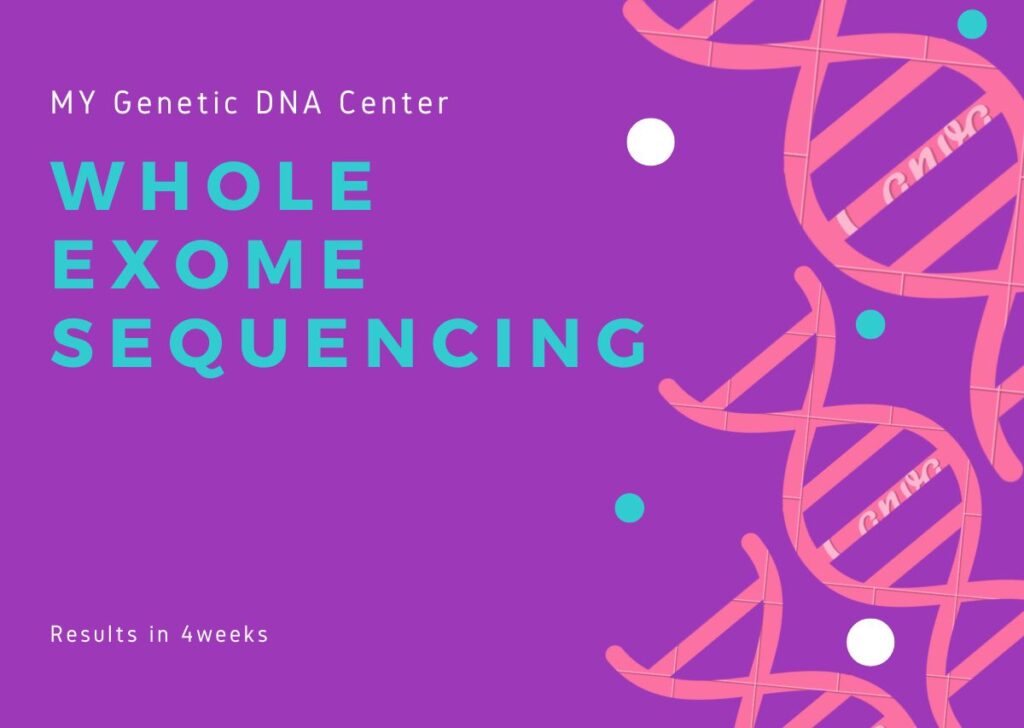
Whole Exome Sequencing (WES)
Whole Exome Sequencing (WES) has emerged as a powerful tool in the field of genomic medicine. Designed to investigate the root genetic causes of rare, undiagnosed, or inherited diseases, WES enables scientists and clinicians to focus on the most informative portion of the human genome—the exome.This technique detects mutations that alter protein production and function, offering critical insight for accurate diagnosis, targeted treatment, and informed family planning.
What Is Whole Exome Sequencing?
Whole Exome Sequencing (WES) It is a molecular diagnostic technique that specifically sequences all the protein-coding regions (exons) of the genome. Although the exome comprises only 1–2% of the entire human genome, it nonetheless carries approximately 85% of all known disease-related mutations. Therefore, it serves as an especially valuable and efficient target for genetic analysis in clinical diagnostics. WES selectively sequences these regions to uncover alterations (mutations) that may be responsible for a patient’s medical condition.
Why Focus on the Exome?
The exome includes genes that directly code for proteins—molecules that perform essential functions within the body. Because most genetic diseases stem from defects in protein structure or function, focusing on protein-coding regions is not only highly efficient but also one of the most informative strategies for uncovering the genetic basis of disease. WES provides a focused approach that balances depth of information with cost and turnaround time.
How Does WES Work?
WES involves several precise steps:
- Sample Collection : The healthcare provider collects a small sample of blood or saliva from the patient.
- DNA Extraction : The laboratory extracts genetic material (DNA) from the sample.
- Sequencing : Using high-throughput next-generation sequencing (NGS), the lab sequences the exonic regions of the genome.
- Bioinformatics Analysis : Experts analyze the sequence data and compare it with reference genomes to detect genomic variants, mutations, or pathogenic alterations.
- Clinical Interpretation : Genetic specialists analyze the findings and match them with the patient’s symptoms to determine whether the genetic variants cause the medical condition.
In some cases, clinicians sequence samples from the patient and both parents through trio-based WES to improve clarity, particularly in identifying de novo mutations that neither parent carries.
Types of Variants Detected by WES
WES can detect various types of genetic alterations, including:
- Missense and nonsense mutations
- Frameshift insertions and deletions
- Splice site alterations
- Copy number variations (with limited sensitivity)
- Compound heterozygous mutations in autosomal recessive disorders
When Is WES Recommended?
Doctors or clinical geneticists may recommend WES when:
- A patient presents with unexplained developmental delays, neurological symptoms, or congenital anomalies.
- Previous tests failed to provide a diagnosis.
- The patient’s family history shows signs of suspected inherited disorders.
- The symptoms are complex, overlapping, or suggest a rare genetic condition.
Key Benefits of Whole Exome Sequencing
Focused and High-Yield :
By targeting the exome, WES avoids scanning non-coding regions and focuses on the sections most likely to contain clinically relevant mutations.
Faster Diagnosis :
WES can help shorten the diagnostic odyssey by identifying the cause of a condition more efficiently than traditional single-gene or panel tests.
Supports Precision Medicine :
WES provides valuable insights that help physicians create personalized treatment plans tailored to the patient’s unique genetic profile.
Family Planning and Risk Assessment :
Results from WES can help families understand inheritance patterns and make informed decisions about future pregnancies or testing for other relatives.
Limitations of Whole Exome Sequencing
Despite its advantages, WES does have limitations:
- It may miss mutations in non-coding regions, introns, or regulatory elements.
- Structural variants and large deletions may be difficult to detect.
- Some detected variants may be of uncertain clinical significance (VUS).
- Genetic specialists may reveal incidental or secondary findings that do not relate to the original reason for testing, which raises both ethical and emotional considerations for patients and providers.
Whole Exome Sequencing vs. Whole Genome Sequencing
Although WES primarily focuses on protein-coding regions, by comparison, Whole Genome Sequencing (WGS) analyzes the entire genome, including introns, regulatory sequences, and non-coding DNA. Furthermore, WGS delivers a more comprehensive view of genetic information. Nevertheless, it tends to be more costly and time-consuming. Consequently, healthcare professionals must carefully consider the advantages and drawbacks of each method in relation to the patient’s specific clinical requirements.
Clinical Applications of WES
WES has become a critical tool in diagnosing:
- Neurological disorders (e.g., epilepsy, ataxia, intellectual disability)
- Metabolic and mitochondrial diseases
- Cardiomyopathies and arrhythmias
- Rare syndromes with no known genetic cause
- Pediatric developmental disorders
Ethical Considerations
Because WES can uncover incidental findings—such as mutations linked to adult-onset cancers or cardiovascular risks—pre-test counseling becomes particularly important. Furthermore, genetic counselors clearly explain the potential results and ensure that patients remain fully informed and well-prepared to make thoughtful decisions about their healthcare. Healthcare providers actively discuss the test’s scope, outline the possible outcomes, and address patients’ preferences concerning secondary findings.
The Role of Genetic Counseling
Genetic counselors play a vital role in WES by:
- Preparing patients and families for potential outcomes
- Explaining complex results in a clear and compassionate manner
- In addition, genetic counselors offer guidance on the next steps for treatment or, if necessary, recommend further testing to clarify the diagnosis.
- Helping families make informed reproductive decisions
Conclusion
Whole Exome Sequencing represents a breakthrough in the field of molecular diagnostics, offering a detailed look into the most critical parts of our DNA. Whole Exome Sequencing (WES) has transformed the understanding and management of rare genetic diseases and unexplained conditions. As genomic technologies advance, clinicians increasingly adopt WES due to its growing accessibility, affordability, and integration into routine medical care. Furthermore, as its clinical role expands, WES actively improves early diagnosis and directly supports the delivery of more personalized, targeted, and effective treatment strategies across a wide range of medical specialties.

